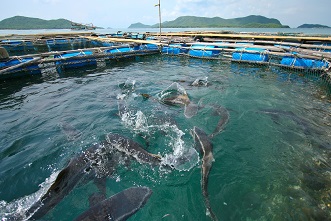Cleaning up in aquaculture

date: 06/08/2015
Project: The development of a deammonification tr...
acronym: DEAMMRECIRC
See also: CORDIS
In many parts of the world, wild-fish stocks are falling or stagnating. A thriving aquaculture sector is vital to take the pressure off fishing fleets and help feed a rapidly growing world population.
In the EU-funded DeammRecirc project, African and European partners developed innovative solutions for aquaculture waste treatment that may reduce the costs of ‘recirculation aquaculture systems’ (RAS) that purify and reuse the water in fish farm tanks. The technology also reduces the flows of harmful chemicals such as nitrates into the environment, in particular into rivers and seas. It achieves this by converting them into harmless nitrogen gas which is released into the atmosphere.
RAS are highly desirable because they take up less space and allow much higher fish-stock densities – thus they are more productive. However, fish produce chemical and organic waste that must be removed to maintain a healthy, productive stock. Currently, this is achieved by a mixture of mechanical and biological filters.
A central part of this existing purification process is a bio-filter that converts toxic ammonia and nitrite waste-products into less-harmful nitrates. But these nitrates can build up to dangerous levels in the recirculation system, so waste water is periodically released into the environment and replaced with fresh water.
This nitrate-rich effluent can cause eutrophication (excess nutrients) in the waters where it is released, which causes algal growth, reduces oxygen concentrations and kills many native organisms. In addition, as the bio-filter consumes oxygen it can lower the pH in the recirculation water, making it more acidic. This requires the addition of expensive buffer chemicals to restore equilibrium.
Reactor for recycling
According to the DeammRecirc team, the problem with this current practice is that it does not go far enough. In the same way that plants ‘fix’ nitrogen from the atmosphere such that it enters the food chain, so the end point of the fish-farming process should restore this nitrogen to the atmosphere as harmless nitrogen gas, rather than letting it accumulate in rivers, lakes and seas.
The DeammRecirc partners have adapted an existing ‘deammonification’ technology – used successfully in the waste water treatment industry – to the particular needs of RAS aquaculture.
A first step was to create an ‘anammox’ bacterial culture that could convert ammonia and nitride to nitrogen in fresh and salt-water environments. The team created a salt-water tolerant culture using the waste sludge produced by sea bass fish farming. In fact, the process used to create this culture can be used by fish farmers to produce their own ‘home-grown’ varieties. This culture was then used in the DeammRecirc prototype reactor.
In their reactor, waste water and sludge first undergo a nitrification pre-treatment that partly converts ammonia into nitrite. The effluent is then passed to the main anammox reactor containing the sludge. Here the nitrite and ammonia are converted into nitrogen gas through bacterial action. By the end of the project, the technology had undergone successful tests using pilot plants. In one, operating for 10 months, very high anammox activity was observed.
Partners are now working on further developing DeammRecirc’s technology with the aim of creating commercial applications for the aquaculture sector. They expect that a fully developed and automated technology will reduce production costs, have a lower carbon footprint, reduce the levels of nitrates released to the environment and reduce the extraction of clean water. It is also expected to give the partners a competitive advantage in the rapidly growing global markets for farmed fish products, including the South African partner – the Marine Finfish Farmers Association of South Africa – which plans to implement the technology further.
Check also our publication Investing in European success - EU-Africa cooperation in science, technology and innovation
